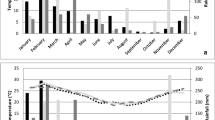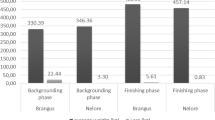Abstract
Two herds of experimental Sanga cattle were maintained under traditional savanna grazing management for three years in the Central Province of Zambia. One herd was kept free of ticks by regular acaricide treatment, while the other was given no tick control. Milk production, growth rate, fertility and mortality were monitored throughout the trial. The tick-free herd performed significantly better than the tick-infested herd, but the value of the additional production was much less than the cost of the acaricide used. it is concluded that there is no economic justification for intensive tick control under these conditions. However, strategic tick control would be justified if the quantity of acaricide used could be reduced by 50% without any major reduction in benefits. The results indicate that treating calves below 45 days of age reduces their performance, as does treating cows during periods of very low tick challenge. Therefore, it seems likely that economically beneficial strategic tick control policies could be developed.
Similar content being viewed by others
References
Ellis, P.R., 1986. Interactions between parasite and vector control, animal productivity and rural welfare. In: M.J. Howell (Editor), Parasitology Quo Vadit? Australian Academy of Science, Canberra, pp. 577–585.
James, A.D. and Villamil, L.C., 1986. Cattle Production Efficiency Calculator (CPEC) User Guide. Mimeographed.
Lamond, D.R., Holmes, J.H.G. and Haydock, K.P., 1964. Estimation of yield and composition of milk produced by grazing beef cows. J. Animal Sci., 29: 606–611.
Morris, R.S. and Meek, A.H., 1980. Measurement and evaluation of the economic effects of parasitic disease. Vet. Parasitol., 6: 165–184.
Pegram, R.G. and Chizyuka, H.G.B., 1987. Towards an assessment of the impact of ticks on rural development. In: R.W. Sutherst (Editor), Ticks and Tickborne Disease. A.C.I.A.R. Proc., 17: 104–107.
Pegram, R.G., Perry, B.D., Musisi, F.L. and Mwanaumo, B., 1986. Ecology and phenology of ticks in Zambia: seasonal dynamics on cattle. Exp. Appl. Acarol., 2: 25–45.
Pegram, R.G., Lemche, J., Chizyuka, H.G.B., Sutherst, R.W., Floyd, R.B., Kerr, J.D. and McCosker, P.J., 1989a. Ecological aspect of cattle tick control in central Zambia. Med. Vet. Entomol., 3: 307–312.
Pegram, R.G., Lemche, J., Chizyuka, H.G.B., Sutherst, R.W., Floyd, R.B., Kerr, J.D. and McCosker, P.J., 1989b. Effect of tick control on liveweight gain of cattle in central Zambia. Med. Vet. Entomol., 3: 313–320.
Putt, S.N.H., Shaw, A.P.M., Woods, A.J., Tyler, L. and James, A.D., 1987. Veterinary Epidemiology and Economics in Africa. I.L.C.A., Addis Ababa, Manu. 3.
Steelman, D.C., 1976. Effects of external and internal arthropod parasites on domestic livestock production. Annu. Rev. Entomol., 21: 155–178.
Sutherst, R.W., 1986. Epidemiological concepts and strategies for parasite control: what changes are likely to occur? In: M.J. Howell (Editor), Parasitology Quo Vadit? Australian Academy of Science, Canberra, pp. 721–729.
Sutherst, R.W. and Kerr, J.D., 1987. Loss in livestock productivity caused by ticks and tickborne diseases. In: R.W. Sutherst (Editor), Ticks and Tickborne Diseases. A.C.I.A.R. Proc., 17: 104–107.
Author information
Authors and Affiliations
Rights and permissions
About this article
Cite this article
Pegram, R.G., James, A.D., Oosterwijk, G.P.M. et al. Studies on the economics of ticks in Zambia. Exp Appl Acarol 12, 9–26 (1991). https://doi.org/10.1007/BF01204396
Accepted:
Issue Date:
DOI: https://doi.org/10.1007/BF01204396




